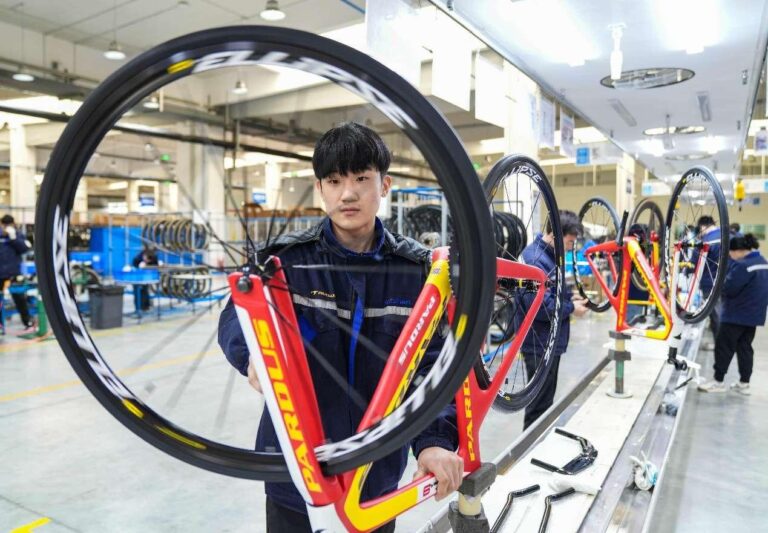
By Fan Jiayuan, As the 9th Asian Winter Games lit up Harbin in northeast China’s Heilongjiang province, another story of transformation was unfolding in the country’s southeast. Shortly after the games, International Olympic Committee (IOC) President Thomas Bach visited a sports equipment company in Fujian province – a stop that underscored the expanding global reach of China’s sporting goods industry.
In 2024, China’s exports of sporting goods climbed to $28.396 billion – a 6.77 percent year-on-year increase, according to data from the China Sporting Goods Federation (CSGF). The figures point not only to the resilience of China’s sporting goods manufacturing but also to a strategic shift toward innovation, brand building, and enhanced international influence.
At the bustling industrial park of Impulse (Qingdao) Health Tech Co., Ltd. in Jimo district of Qingdao, east China’s Shandong province, overseas orders for fitness equipment continue to flood in. This fitness equipment manufacturer has established a strong presence in European and American markets with its product range of treadmills, elliptical trainers, and stationary bikes. By investing in design, research, and advanced manufacturing, it meets the exacting standards of discerning global buyers.
“A single treadmill incorporates more than 100 distinct components – from minute screws to the running belts – and every part must adhere to rigorous market standards. Our collaboration with over 200 suppliers makes this quality possible,” said Liu Hongtao, chairman and president of the company.
The broader sector reflects a similar trend of growth and innovation. Chinese-made fitness equipment exports leaped by 22.13 percent to $5.047 billion in 2024, marking two consecutive years of strong growth. Jiao Ni, deputy secretary-general of the CSGF, noted that following a global restructuring of supply chains and a reduction in excess inventory, the international sporting goods market is beginning to rebound.
“Chinese companies benefit from a complete industrial chain that enables rapid production, efficient order fulfillment, and a broader range of product offerings,” Jiao explained.
She emphasized that while other countries also produce sporting goods, their higher production costs diminish competitiveness. In contrast, China’s self-sufficient supply chain – from raw materials to finished products – provides a decisive edge in both stability and pricing.
In east China’s Anhui province, Dai Jianlin, chairman of Anhui Sawy Sports Goods Co., Ltd., shared a similar sentiment. His company reported annual revenues of 150 million yuan (about $20.65 million) in 2024, with exports accounting for nearly 90 million yuan – an increase of almost 50 percent from the previous year. Technological advances, such as automation that trims shuttlecock production time to just 90 seconds, have enabled the company to cut costs by 50 percent while significantly enhancing production durability.
“We export shuttlecocks to more than 70 countries and regions, and our quality speaks to itself – orders are booked four to five months in advance,” Dai said.
A broader shift is taking place as Chinese companies move from being mere original equipment manufacturers (OEM) to developing robust domestic brands, bolstered by enhanced innovation and research capabilities. Data shows that while processing trade accounted for roughly 55 percent of China’s export structure at the end of the last century, it now comprises less than 20 percent – while general trade has surged to nearly 70 percent. This shift signals the successful transformation and upgrading of the country’s sports manufacturing industry.
In southeast China’s Fujian province – historically renowned for OEM footwear and apparel – the sports industry has made significant inroads in overseas markets. On the eve of the Paris 2024 Olympic Games, Xiamen Customs processed 23 shipments containing 19,000 items of clothing, athletic shoes, and related gear for the IOC.
By shifting focus from sheer export growth volume to robust brand marketing, and forging partnerships with international sporting events and high-profile endorsements, Chinese sports products are shedding their “price advantage” image in favor of a compelling “value advantage.” They are not only meeting global market demands but also emerging as competitive players on the global stage.










